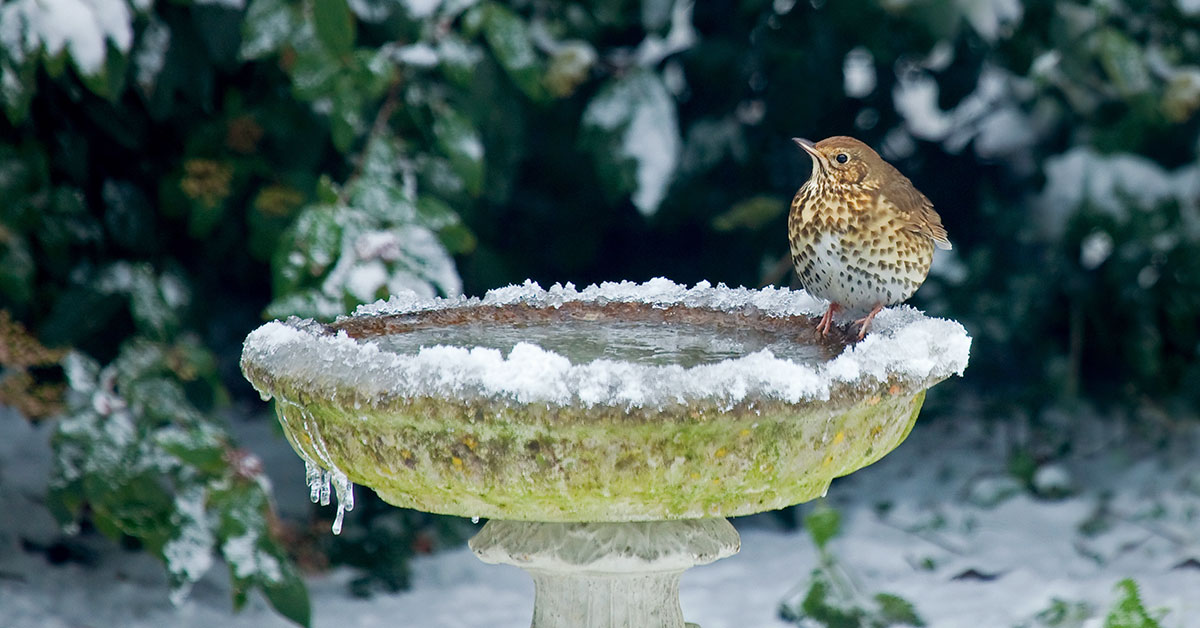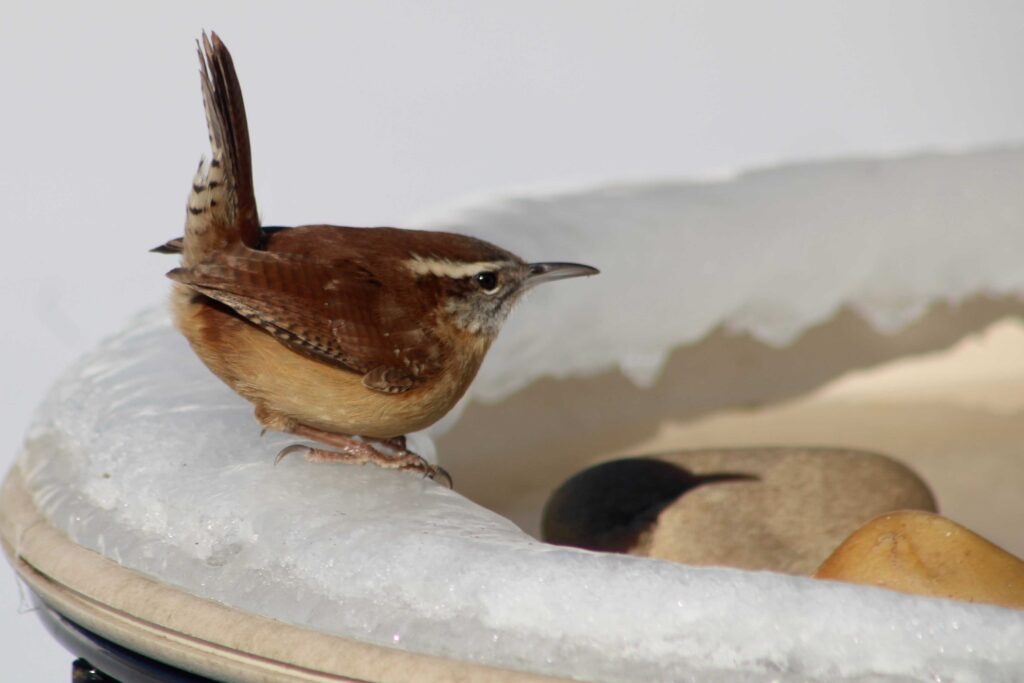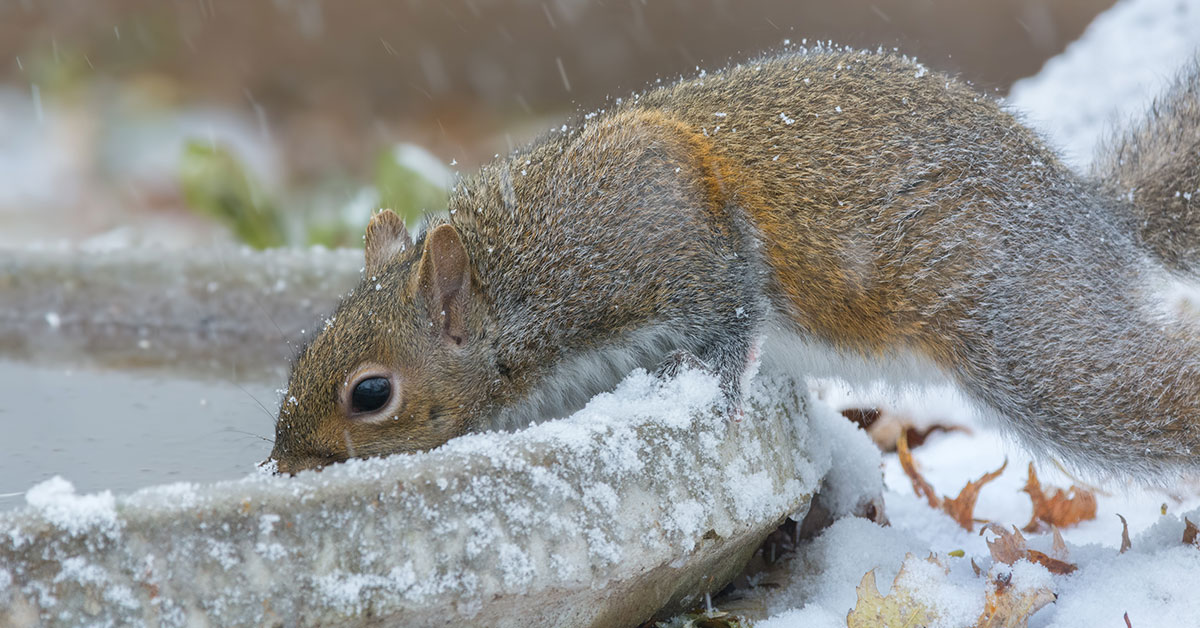Birds need water to survive, so keeping a bird bath full of fresh water will attract many different species. Here are some tips on how to keep your bird bath filled with water all year round.
Do Birds Need Water in Winter?
Winter is here, and the birds in your backyard are thirsty. Sure, they can get liquid from snow, but to process it, they must warm it up. Birds have to expend precious calories and use the warmth of their bodies to melt the snow.
To conserve energy in the winter, birds need to drink liquid water. But how do you keep your bird bath from freezing when the temperature drops below freezing?

Birds Need Food, Water, and Cover: Backyard Habitat
Did you know there are three main things backyard wildlife needs to survive in your yard? These three things are food, water, and cover. If you provide all three in your garden, you’ll be blessed with wildlife – birds, small mammals, and more!
We readily think of adding bird feeders in the fall and winter when plants aren’t producing berries or seeds, but sometimes we don’t think about helping birds and other wildlife by providing a water source. Birds need water in the winter too!
A liquid water source might attract more birds and animals on frigid days in the winter than the feeders.
What Type of Bird Bath to Use in Winter: Concrete, Metal, or Glass
As water freezes, it expands, which can cause cracks or even break certain types of bird baths. Bird baths made of concrete or glass can crack or even shatter. Pick a bird bath made of a sturdier material that can withstand fluctuating temperatures.
I forgot a lovely glass bird bath out one night when the temperatures dropped below freezing and found it shattered in pieces the following day. Lesson learned.
The metal bird bath we now have handles the winter temperatures just fine without fear of cracking. If you like the look of a glass or concrete bird bath, you can always switch it out seasonally. While metal is great for a winter birdbath, if placed in the sun, it might be too hot in the summer.
TIP: If you do have a cracked bird bath, try recycling it into a planter!
Your bird bath should allow birds to drink without getting in the water. So if your birdbath is deep, consider placing some rocks in it to provide a place for birds to perch on to stay dry while drinking.

How to Keep Water from Freezing in Your Bird Bath in Winter
There are several options for ensuring your bird bath has liquid water available for wildlife and birds. The option you choose may depend on where you live and how often the water freezes.
1. Change the Water Daily
Where I live, the water doesn’t freeze all that often. Generally, I dump out the ice and fill the birdbath with fresh water from the house.
If you need to pour warm water into the bath to break up the ice, make sure to use cool water to fill the bath when you are finished.
Hot water is not recommended for wildlife and may injure an animal. Hot water may also crack your bird bath if the temperature difference is too significant.
2. Use a Bird Bath Heater or Heated Bird Bath
If you live farther north and have many days where your bird bath is frozen, you might want a less labor-intensive solution.
The perfect solution is a bird bath heater (also known as a bird bath de-icer) that sits in the water or a bird bath with a built-in heater.
Consider which options will work best when picking a bird bath heater. Some heaters are thermostat controlled and only turn on at certain temperatures; others will turn off if the water level drops too far. The more features it has, the more it will cost.

Safety Recommendations for Winter Bird Baths
You should only plug a heated bird bath or a bird bath de-icer into a GFCI (ground fault circuit interrupter) outlet. This type of outlet reduces the risk that you or the birds get a shock (since we are dealing with water).
GFCI outlets are the same ones required for use next to sinks and baths in your house. So if you drop your hair dryer into a sink full of water, it will cut the power, saving you from electrocution.
If you use an extension cord to reach your bird bath, consider using waterproof plastic covers for the outlet for outdoor use that protects the connections from the weather. Don’t let your cords get buried in the snow. There are many options for these covers as well.
DO NOT mix anything in the water to keep it from freezing, such as antifreeze, glycerin, sugar, salt, or another chemical. All of these things can cause harm to birds and wildlife.
Additional Tips for Heating and Cleaning Your Winter Bird Bath
- If you move your bird bath into a sunny spot for the winter, the ice will melt faster, and the water will warm up a little quicker too.
- Don’t forget to clean your bird bath. Even in winter, bird baths will get dirty and need to be cleaned. Clean it out every couple of days – and even more frequently if you have lots of leaves falling in it or lots of birds visiting.
DIY Bird Bath Heater Using Light Bulb
You can avoid the expense of a birdbath heater by making your own. This DIY heated birdbath quick tip comes from the Cornell Lab of Ornithology and Audubon:
A homemade solution is to put a light bulb in a flower pot and place the water basin on top. The light bulb will provide more than enough heat to keep the water from freezing.
(SOURCE: http://com-bbimages.s3.amazonaws.com/bbimages/gbbc-email/ProvidingWater.pdf)
Again, I recommend using a GFCI outlet for outdoor use and a waterproof plastic cover for any plug connections.
Try it and see if it works for you!
My Friendly Reminder From a Squirrel
After seven days of lovely, seventy-degree temperatures, the weather turned bitterly cold this week. I awoke to temperatures in the 20’s.
While eating my breakfast, I looked out the window to find a squirrel perched on our bird bath, sipping at the edges. Most of the water in the bath was completely frozen, but there was a tiny liquid portion at the very edge.

That was my reminder to change the water in the bird bath. Even in the winter, maybe especially in the winter, birds and other backyard wildlife need water (in liquid form) to survive.
I dumped out the solid block of ice and then refilled the bird bath with fresh, non-frozen water. Just a few minutes later, the first bird landed on it and took a sip.
